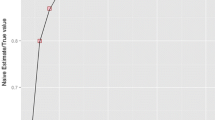Abstract
Purpose. To compare the effectiveness of various metrics which evaluate bioequivalence in the early phase of concentration-time profiles.
Methods. Two-period crossover trials were simulated with increasing assumed ratios of the true absorption rate constants of the two formulations, and with various kinetic models. Kinetic sensitivities (KS) and standard errors (SE) of the various metrics were recorded and the percentage of trials accepting bioequivalence (the statistical power) was evaluated. The principal metrics included the partial AUC (AUC P) the intercept obtained by linear extrapolation of the ratios of the lower over higher concentrations (C) measured for the two formulations (I L /H), and the ratios of intercepts extrapolated from logarithmic C/ time values of the two products (M log). For comparison, also properties of C maxand an ideally evaluated measure (Id) were determined.
Results. M logshowed generally the highest statistical power and KS, and also the largest SE, closely followed by I L /H. Partial AUC exhibited lower power and KS, but also smaller SE than the intercept procedures. The three methods had much higher power, KS and SE than C max. These comparisons were maintained over various kinetic conditions and experimental designs. The effective evaluation of bioequivalence in the early phase of studies is assured with 3 (or more) measurements until the population average peak of the reference formulation.
Conclusions. The three principal methods assess bioequivalence very effectively in the early phase of a concentration-time profile. M loghad the highest statistical power, closely followed by IL /Hand then by partial AUC.
Similar content being viewed by others
REFERENCES
M-L. Chen. An alternative approach for assessment of rate of absorption in bioequivalence studies. Pharm. Res. 9:1380-1385 (1992).
L. Endrenyi and P. Al-Shaikh. Sensitive and specific determination of the equivalence of absorption rates. Pharm. Res. 12:1856-1864 (1995).
P. Macheras, M. Symillides, and C. Reppas. An improved intercept method for the assessment of absorption rate in bioequivalence studies. Pharm. Res. 13:1755-1758 (1996).
L. Endrenyi, S. Fritsch, and Y. Wei. Some kinetic and statistical considerations on the evaluation of comparative absorption rates. In I. J. McGilveray, S. V. Dighe, I. W. French, K. K. Midha, and J. P. Skelly (eds.), “Issues in the Evaluation of Bioavailability Data, BioInternational'89”, Toronto, pp. 43-48 (1989).
F. Y. Bois, T. N. Tozer, W. W. Hauck, M. L. Chen, R. Patnaik, and R. L. Williams. Bioequivalence: performance of several measures of rate of absorption. Pharm. Res. 11:966-974 (1994).
A. Rostami-Hodjegan, P. R. Jackson, and G. T. Tucker. Sensitivity of indirect metrics for assessing “rate” in bioequivalence studies—Moving the “goalpost” and changing the “game”. J. Pharm. Sci. 83:1554-1557 (1994).
L. F. Lacey, O. N. Keene, C. Duquesnoy, and A. Bye. Evaluation of different indirect measures of rate of drug absorption in comparative pharmacokinetic studies. J. Pharm. Sci. 83:212-215 (1994).
J. Zha, L. Tothfalusi, and L. Endrenyi. Properties of metrics applied for the evaluation of bioequivalence. Drug Inf. J. 29:989-996 (1994).
T. N. Tozer, F. Y. Bois, W. W. Hauck, M-L. Chen, and R. L. Williams. Absorption rate vs. exposure: which is more useful for bioequivalence testing? Pharm. Res. 13:453-456 (1996).
L. Endrenyi, F. Csizmadia, L. Tothfalusi, A. H. Balch, and M.-L. Chen. The duration of measuring partial AUCs for the assessment of bioequivalence. Pharm. Res. 15:399-404 (1998).
L. Endrenyi, L. Tothfalusi, and J. Zha. Metrics assessing the equivalence of absorption rates and concentration profiles. In K. K. Midha, and T. Nagai (eds.), “F.I.P. Bio-International'96: Bioavailability, Bioequivalence, and Pharmacokinetic Studies”, Academic Societies Japan, Tokyo, pp. 169-180 (1996).
D. J. Schuirmann. A comparison of the two one-sided tests procedure and the power approach for assessing the equivalence of average bioavailability. J. Pharmacokin. Biopharm. 15:657-680 (1987).
L. Tothfalusi and L. Endrenyi. Without extrapolation, Cmax/AUC is an effective metric in investigations of bioequivalence. Pharm. Res. 12:937-942 (1995).
Author information
Authors and Affiliations
Rights and permissions
About this article
Cite this article
Endrenyi, L., Csizmadia, F., Tothfalusi, L. et al. Metrics Comparing Simulated Early Concentration Profiles for the Determination of Bioequivalence. Pharm Res 15, 1292–1299 (1998). https://doi.org/10.1023/A:1011912512966
Issue Date:
DOI: https://doi.org/10.1023/A:1011912512966




